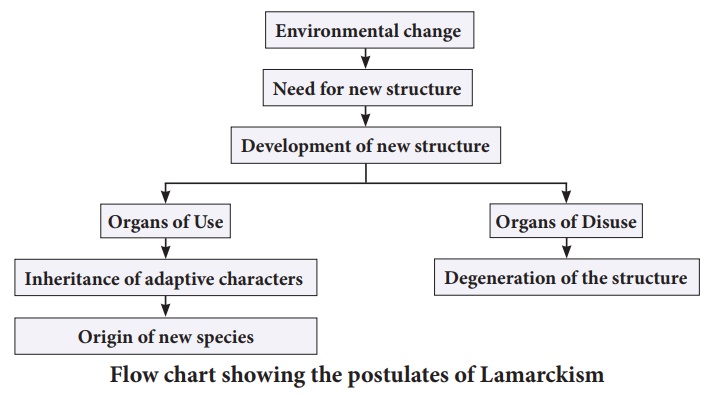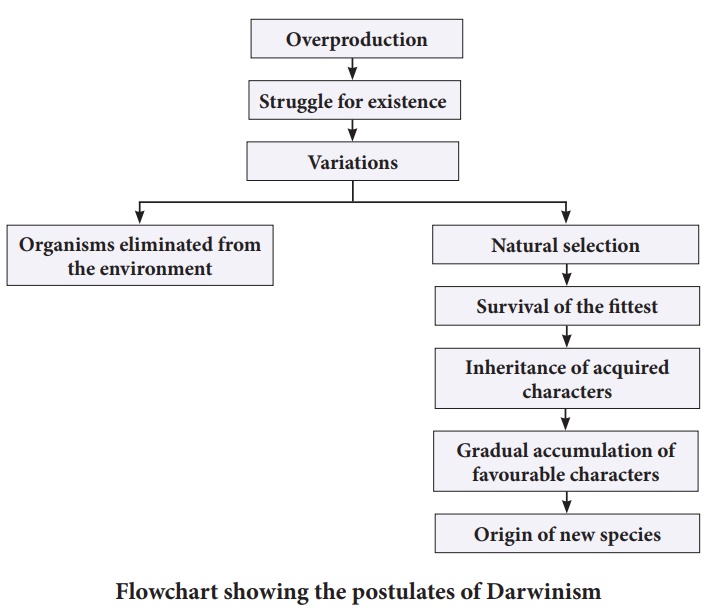Lamarckism, Darwinism - Theories of Evolution | 10th Science : Chapter 19 : Origin and Evolution of Life
Chapter: 10th Science : Chapter 19 : Origin and Evolution of Life
Theories of Evolution
Theories
of Evolution
Life had evolved along
with evolution of earth towards the end of 18th century. Evolution is
the gradual change occurring in living organisms over a period of time.
Formation of new species due to changes in specific characters over several
generations as response to natural selection, is called evolution. The natural
changes occuring is explained through the theories of evolution as proposed by
Lamarck and Darwin.
1. Lamarckism
Jean Baptiste Lamarck
(1744 -1829) was a French naturalist, well known for his theory of evolution.
Lamarck’s theory of evolution was published in ‘Philosophic Zoologique’
in the year 1809. It is popularly known as ‘Theory of inheritance of
Acquired Characters” or “Use and Disuse theory” or Lamarckism.
Principles of Lamarckism
i. Internal vital force
Living organisms or
their component parts tend to increase in size continuously. This increase in
size is due to the inherent ability of the organisms.
ii. Environment and new needs
A change in the
environment brings about changes in the need of the organisms. In response to
the changing environment, the organisms develop certain adaptive characters.
The adaptations of the organisms may be in the form of development of new parts
of the body.
iii. Use and disuse theory
Lamarck’s use and
disuse theory states that if an organ is used constantly, the organ develops
well and gets strengthened. When an organ is not used for a long time, it
gradually degenerates.
The ancestors of giraffe
were provided with short neck and short forelimbs. Due to shortage of grass,
they were forced to feed on leaves from trees. The continuous stretching of
their neck and forelimbs resulted in the development of long neck and long
forelimbs which is an example for constant use of an organ. The degenerated
wing of Kiwi is an example for organ of disuse.
iv. ![]()
![]() Theory of
Inheritance of acquired characters
Theory of
Inheritance of acquired characters
When there is a change
in the environment, the animals respond to the change. They develop adaptive
structures. T e characters developed by the animals during their life time, in
response to the environmental changes are called acquired characters.
According to Lamarck, the acquired characters are transmitted to the offspring
by the process of inheritance.
2. Darwinism or Theory of Natural Selection
Charles Darwin (1809-1882) was one of the great naturalist and philosopher of 18th century. He was born in England in 1809. While studying in college through his friendship with Professor J.S.Henslow he was fascinated towards nature. At that time the British Admiralty planned a voyage of exploration for 5 years on a ship named H.M.S. Beagle around South America. Dr Henslow was asked to nominate a young naturalist for the voyage. Darwin was given the opportunity. During his five years (1831–1835) voyage he visited many parts of the world, a number of islands including the Galapagos island and Pacific island.
Darwin
made elaborate observations on nature of the land, plants and animals of
the regions he visited. He further worked for a period of 20 years to develop
the theory of natural selection.

Darwin published his
observations and conclusions under the name ‘Origin of species’ in 1859.
The book of Darwin demonstrates the fact of evolution. It elaborates on the theory
of Natural selection for evolutionary transformation,
Principles of Darwinism
i. Overproduction
Living beings have the
ability to reproduce more individuals and form their own progeny. They have the
capacity to multiply in a geometrical manner. This will increase reproductive
potential leading to overproduction.
ii. Struggle for existence
Due to over production,
a geometric ratio of increase in population occurs. The space to live and food
available for the organisms remain the same. This creates an intense
competition among the organisms for food and space leading to struggle. The
struggle for existence are of three types:![]()
![]()
a. Intraspecific struggle:
Competition among the individuals of same species.
b. Interspecific struggle:
Competition between the organisms of different species living together.
c. Environmental struggle: Natural conditions like extreme heat or cold, drought and floods
can affect the existence of organisms
iii. Variations
The occurrence of
variation is a characteristic feature of all plants and animals. Small
variations are important for evolution. According to Darwin favourable
variations are useful to the organism and unfavourable variations
are harmful or useless to the organism.
iv. Survival of the fittest or Natural selection During the struggle for existence, the organisms which can overcome the challenging situation, survive and adapt to the surrounding environment.
Organisms which are unable to face the challenges, are unfit to
survive and disappear. The process of selection of organisms with favourable
variation is called as natural selection.

v. Origin of species
According to Darwin, new
species originates by the gradual accumulation of favourable variations for
a number of generations.
Related Topics